- Scientific name: Carex formosa Dewey
- Species of Greatest Conservation Need (MA State Wildlife Action Plan)
- Threatened (MA Endangered Species Act)
Description
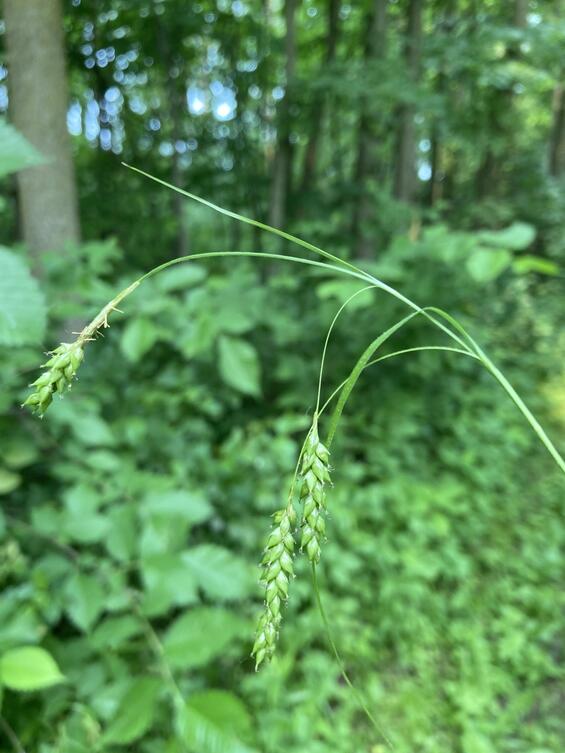
Fruiting spikes (photo credit: Eleanor Ray)
Handsome sedge, Carex formosa, is a slender, grass-like perennial in the sedge family (Cyperaceae). Carex is a large genus that has been subdivided into sections. Handsome sedge has been put in section Hymenochlaenae. Sedges in this section have long drooping peduncles with spikes. It grows in clumps that are 3-7 dm (0.75-2.5 ft) in height, and its culms, or stems, are tinged with purple or maroon at the base. The leaves are M-shaped in cross-section and are 3-7 mm (0.12-0.28 in) wide, very thin, and hairy underneath. The leaf sheaths are also hairy.
To positively identify handsome sedge and other members of the genus Carex, a technical manual should be consulted. Species in this genus have tiny, wind-pollinated flowers that are borne in spikes. Each flower is unisexual, and is closely subtended by small, flat scales that sometimes conceal the flowers. The staminate (i.e., pollen-bearing) flowers are subtended by a single scale. The pistillate (i.e., ovule-bearing) flowers are subtended by two scales, an outer flat scale (“pistillate scale”) and an inner, sac-like scale, called a “perigynium,” that encloses the flower, and later, the achene (fruit). If the perigynium tapers or contracts to a tip, it is described as a “beak.”
Handsome sedge's much-reduced flowers are clustered in spikes (unbranched, usually elongate inflorescences in which the flowers are stalkless) that contain a mixture of male and female flowers. The terminal spike of C. formosa is mostly staminate, or male, with only a few pistillate, or female, flowers at its summit. In contrast, the 1–3 cm (0.4-1.2 in) long lateral spikes are mostly pistillate, with a few staminate flowers at the base, and are borne on thin, downward curving peduncles (the stalks of inflorescences). These peduncles are longer than the spikes. The inflated, 3.5-5 mm (0.16-0.2 in) long perigynia are topped by short beaks, and are sub-tended by scales that are slightly shorter than the perigynia. The bracts (modified leaves associated with flowers or inflorescences) sheath the stems and become much smaller toward the top of the plant.
Handsome sedge could easily be confused with Davis's sedge (C. davisii). Unlike Davis's sedge, however, handsome sedge has both male and female flowers on its lateral spikes. The lateral spikes of C. davisii are entirely pistillate. In addition, the pistillate scales of Davis's sedge have very long awns (slender bristles located at the top of the scales); those of handsome sedge do not.
Handsome sedge could also be confused with graceful sedge (C. gracillima). The base of both plants is reddish, and the terminal spike contains both staminate florets and perigynia, but the lateral spikes of graceful sedge contain only perigynia, with no staminate florets below them. In addition, graceful sedge perigynia are smaller, only 2-3.7 mm (0.08-0.15 in) long versus handsome sedge’s larger perigynia at 3.5-5 mm (0.14-0.20 in) long.
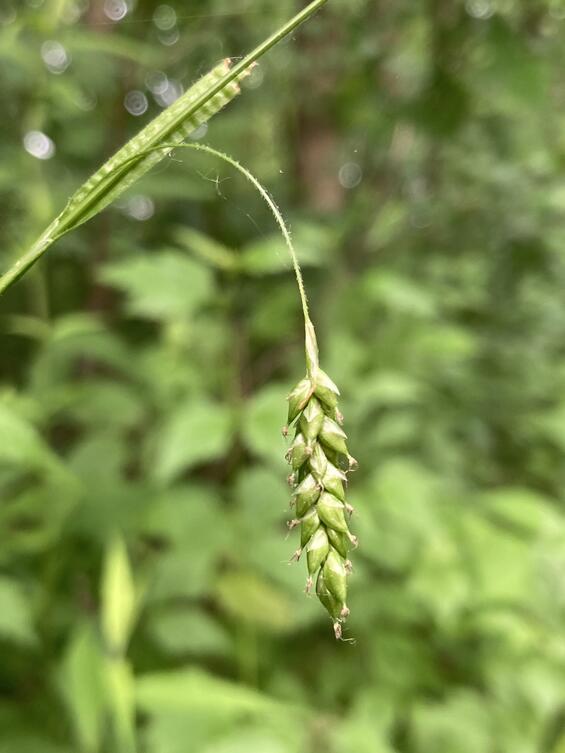
Fruiting spike, showing male flowers below perigynia (photo credit: Eleanor Ray)
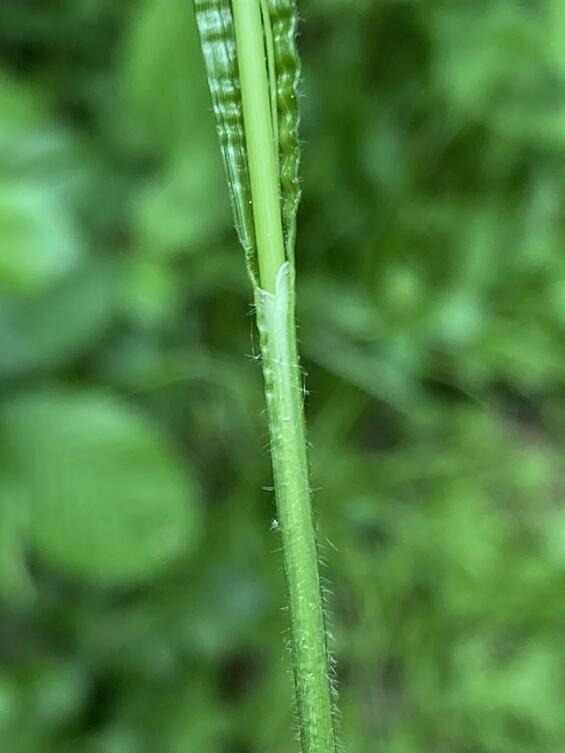
Photo showing the hairiness of leaf and sheath. (photo credit: Eleanor Ray)
Life cycle and behavior
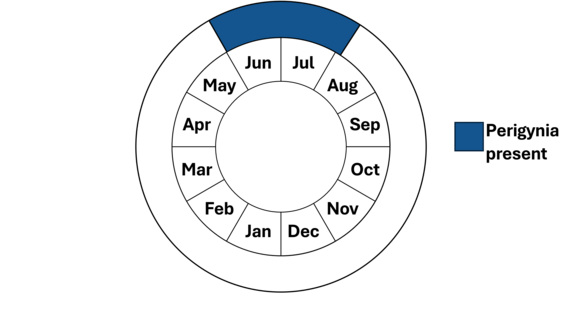
Handsome sedge is a perennial herb that reproduces via short rhizomes and can form dense clonal clumps. It flowers in May and mature perigynia are present from early June through late July. Wind is thought to be the primary pollination mechanism for handsome sedge. Most of the mature achenes are thought to land within a meter of the parent plant as the culms (flowering stems) recline flat on the ground once the perigynia are mature. It is possible that browsing animals may help with distribution of the seeds, but that is not known.
Population status
Handsome sedge is listed under the Massachusetts Endangered Species Act as Threatened. All listed species are protected from killing, collecting, possessing, or sale and from activities that would destroy habitat and thus directly or indirectly cause mortality or disrupt critical behaviors. Handsome sedge is currently known from Berkshire County. There are two current stations (discovered or relocated since 1999) in Berkshire County. Plants have not been relocated at two other sites, also in Berkshire County.
Distribution and abundance
Handsome sedge occurs from southwestern Quebec and southern Ontario to North Dakota, south to New Jersey and Illinois. It is considered rare in all states and provinces where it occurs except in Ontario. In New England, Handsome Sedge is rare in Connecticut and Vermont. It is not known from Maine, New Hampshire, or Rhode Island.
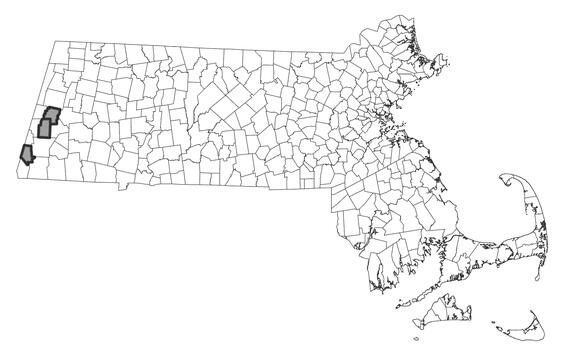
Distribution in Massachusetts
2000-2025
Based on records in the Natural Heritage Database
Habitat
Handsome sedge's habitats include the borders of calcareous marshes and seepage swamps (wet, wooded areas in which groundwater seeps to the surface from a calcareous, gravelly substrate); and moist, open forests. Among the species associated with handsome sedge are white pine (Pinus strobus), white ash (Fraxinus americana), white oak (Quercus bicolor), sugar maple (A. saccharum), red maple (A. rubrum), American hornbeam (Carpinus caroliniana), witch hazel (Hamamelis virginiana), and other sedges (including C. flava and C. gracillima).
Healthy habitats are vital for supporting native wildlife and plants. Explore habitats and learn about conservation and restoration in Massachusetts.
Threats
Competition from exotic invasive shrub species is a threat to handsome sedge populations, which threatens to shade out the populations. Logging is a threat both by accidental running over species, but also by creating forest openings that invasive plants invade and spread out into the forest. Another possible threat is water level rise due to beaver activities. Although it is limited to the northeast, this is due to the presence of calcareous material on which this species thrives, not by a warming climate.
Conservation
Survey and monitoring
In Massachusetts, handsome sedge is only known from Berkshire County which has calcium rich soils which it prefers. As only 2 populations are currently known to be extant, additional survey is needed in appropriate habitats. The best time to survey for handsome sedge is when mature perigynia are present, in June and July.
Management
All populations are in locations where natural processes or human activities have produced disturbed habitats. Monitoring and removal of competing vegetation, particularly non-native invasive species, should be considered as a management strategy where appropriate. All active management of rare plant populations (including invasive species removal) is subject to review under the Massachusetts Endangered Species Act and should be planned in close consultation with the MassWildlife’s Natural Heritage & Endangered Species Program.
Research needs
It is not known how long handsome sedge seeds remain viable, or what the germination requirements are for it. Dodds (2022) notes that other large-seeded sedge species typically have a longer dormancy. It is not known if handsome sedge forms any mycorrhizal associations. Dispersal of this species away from the parent plant is not understood and needs to be researched. Research is needed to determine whether this plant can be grown in a nursery or garden setting for purposes of reintroductions. If habitat degradation accelerates losses of current populations, this strategy could prove useful to long-term conservation of this species.
References
Arsenault, Matt, Glen H. Mittelhauser, Don Cameron, Alison C. Dibble, Arthur Haines, Sally C. Rooney, and Jill E. Weber. 2013. Sedges of Maine, A Field Guild to Cyperaceae. University of Maine Press, Orono, Maine.
Gleason, Henry A., and Arthur Cronquist. Manual of Vascular Plants of Northeastern United States and Adjacent Canada, Second Edition. Bronx, NY: The New York Botanical Garden, 1991.
Haines, Arthur. Flora Novae Angliae. New England Wild Flower Society, Yale University Press, New Haven, CT. 2011.
Dodds, Jill S. 2023. Carex formosa Rare Plant Profile. New Jersey Department of Environmental Protection, State Parks, Forests & Historic Sites, State Forest Fire Service & Forestry, Office of Natural Lands Management, New Jersey Natural Heritage Program, Trenton, NJ. 16 pp. https://www.nj.gov/dep/parksandforests/natural/heritage/docs/carex-formosa-handsome-sedge.pdf
NatureServe. 2025. NatureServe Network Biodiversity Location Data accessed through NatureServe Explorer [web application]. NatureServe, Arlington, Virginia. Available https://explorer.natureserve.org/. Accessed: 3/10/2025.
POWO (2025). "Plants of the World Online. Facilitated by the Royal Botanic Gardens, Kew. Published on the Internet; https://powo.science.kew.org/ Retrieved 3/9/2025."
USDA Natural Resources Conservation Service. https://plants.usda.gov/plant-profile/CAFO4 accessed on 3/7/2025.
Contact
| Date published: | March 26, 2025 |
|---|